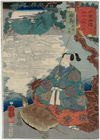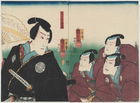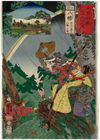Home > Utagawa Kuniyoshi
Utagawa Kuniyoshi

Utagawa Kuniyoshi
Fukushima: Urashima Taro from the series Sixty-nine Stations of the Kisokaido Road (Kisokaido rokujukyu tsugi no uchi)
Utagawa Kuniyoshi
Roben Falls on Mount Oyama (Oyama Roben taki no zu): Actors Kirishima Giemon Onoe Eizaburo III Ichikawa Ebizo V and Nakamura Tsuruzo I
Utagawa Kuniyoshi
Poems by Uma no Naishi and Shosho no Naishi from the series Fashionable Six Female Poetic Immortals (Furyu onna Rokkasen) by the Kyoto Doll Artist (Kyoto ningyoshi) Oishi Ganryusai Yoshihiro
Utagawa Kuniyoshi
Tsumagome: Abe no Yasuna and the Fox Kuzunoha from the series Sixty-nine Stations of the Kisokaido Road (Kisokaido rokujukyu tsugi no uchi)
Utagawa Kuniyoshi
Itahana: Onzoshi Ushiwakamaru from the series Sixty-nine Stations of the Kisokaido Road (Kisokaido rokujukyu tsugi no uchi)
Utagawa Kuniyoshi
A Comical Ken Game (Doke ken awase): Actors Ichikawa Kuzo II as a Tiger Nakamura Utaemon IV as a Toad and Matsumoto Koshiro VI as a Fox
Utagawa Kuniyoshi
Comical Sumo Wrestling Match between the Wind God and a Guardian King (Doke Nio fujin no sumo)
Utagawa Kuniyoshi
Actors Ichikawa Kodanji IV Seki Sanjuro III and Ichikawa Komazo VII as Police Officers (R) and Ichikawa Danjuro VIII as Sanshichiro Yoshitaka (L)
Utagawa Kuniyoshi
The Origin Story of the Cat Stone at Okabe Representing One of the Fifty-three Stations of the Tokaido Road (Mitate Tokaido gojusan tsugi Okabe neko ishi no yurai): Actors Sawamura Sojuro V (?) as Teranishi Kanshin (R) Onoe Kikugoro III as the Spirit of t
Utagawa Kuniyoshi
Yawata: Omi Kotoda and Yawata Saburo from the series Sixty-nine Stations of the Kisokaido Road (Kisokaido rokujukyu tsugi no uchi)
Kuniyoshi Utagawa (Kuniyoshi Utagawa, November 15, 1798 (January 1, 1798)-March 5, 1861 (April 14, 1861)) is an ukiyo-e artist at the end of the Edo period.
The painting was called Kuniyoshi Ichiyusai from the first year of Bunsei to the first year of Man'en, and later called Saihosha (mid-Bunsei), Asasakuraro (first year of Tenpo to the first year of Man'en), Yukitani, and Senshin. In honor of Utagawa, Yanagiyan is used for the Kyoka issue, and Ichimyo Kaijo is used for the hidden issue. One of the leading ukiyo-e artists of the late Edo period, he has a wealth of ideas, innovative design power, strange ideas, and reliable drawing power, and has many works with a wide range of charm that goes beyond the frame of ukiyo-e. Produced.
Born in 1798 in Kansei 9 (1798) in 1-chome, Honshirogane-cho, Nihonbashi, Edo (currently 4-chome, Honshirogane-cho, Nihonbashi, Chuo-ku, Tokyo). My father is Kichiemon Yanagiya, who runs a Kyokonya (dyeing shop). The childhood name is Yoshisaburo Igusa. Later Sonsaburo. Hiroshige Utagawa, who is internationally famous for landscape prints, was born in the same year and was active in the same period. Lives in Mukaishima in the middle of the year.
